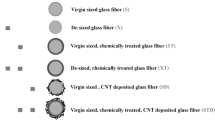Abstract
In this research, we studied low velocity impact response of homogenous basalt fiber-reinforced polymer (BFRP) composites and then compared the impact key parameters with carbon fiber-reinforced polymer (CFRP) homogenous composites. BFRPs and CFRPs were fabricated by vacuum-assisted resin transfer molding (VARTM) method. Fabricated composites included 60% fiber and 40% epoxy matrix. Basalt and carbon fibers used as reinforcement materials were weaved in 2/2 twill textile tip in the structures of BFRP and CFRP composites. We also utilized the energy profile method to determine penetration and perforation threshold energies. The low velocity impact tests were carried out in 30, 60, 80, 100, 120 and 160 J energy magnitudes, and impact response of BFRPs was investigated by related force-deflection, force-time, deflection-time and absorbed energy-time graphics. The related impact key parameters such as maximum contact force, absorbed energy, deflection and duration time were compared with CFRPs for various impact energy levels. As a result, due to the higher toughness of basalt fibers, a better low velocity impact performance of BFRP than that of CFRP was observed. The effects of fabrication parameters, such as curing process, were studied on the low velocity impact behavior of BFRP. The results of tested new fabricated materials show that the change of fabrication process and curing conditions improves the impact behavior of BFRPs up to 13%.


















Similar content being viewed by others
References
S. Carmisciano, I.M.D. Rosa, F. Sarasini, A. Tamburrano, and M. Valente, Basalt Woven Fiber Reinforced Vinylester Composites: Flexural and Electrical Properties, Mater. Des., 2011, 32, p 337–342
L.X. Zhong, S.Y. Fu, X.S. Zhou, and H.Y. Zhan, Effect of Surface Microfibrillation of Sisal Fibre on the Mechanical Properties of Sisal/Aramid Fibre Hybrid Composites, Compos. Part A Appl. Sci., 2011, 4, p 244–252
V. Fiore, G.D. Bella, and A. Valenza, Glass-Basalt/Epoxy Hybrid Composites for Marine Applications, Mater. Des., 2011, 32, p 2091–2099
E. Quagliarini, F. Monnia, S. Lencia, and F. Bondioli, Tensile Characterization of Basalt Fiber Rods and Ropes: A First Contribution, Constr. Build. Mater., 2012, 34, p 372–380
E.E. Mcconnell, O. Kamstup, R. Musselman, T.W. Hesterberg, J. Chevalier, and W.C. Miller, Chronic Inhalation Study of Size-Separated Rock and Slag Wool Insulation Fibers in Fischer 344/N Rats, Inhal. Toxicol., 1994, 6, p 571–614
B. Wei, H. Cao, and S. Song, Tensile Behavior Contrast of Basalt and Glass Fibers After Chemical Treatment, Mater. Des., 2010, 31, p 4244–4250
M. Berozashvili, Continuous Reinforcing Fibers are Being Offered for Construction, Civil Engineering and Other Composites Applications, Adv. Compos. Mater, 2001, 21, p 5–6
C. Schefflera, T. Förster, E. Mäder, G. Heinrich, S. Hempel, and V. Mechtcherine, Aging of Alkali-Resistant Glass and Basalt Fibers in Alkaline Solutions: Evaluation of the Failure Stress by Weibull Distribution Function, J. Non-Cryst. Solids, 2009, 355, p 2588–2595
J. Sim, C. Park, and D.Y. Moon, Characteristics of Basalt Fiber as a Strengthening Material for Concrete Structures, Compos. Part B Eng., 2005, 36, p 504–512
W. Tian, K.H. Leong, A.Y. Leong, F. Fredo, and M. Quaresimin, The Effect of Surface Treatments on the Mechanical Properties of Basalt-Reinforced Epoxy Composites, Polym. Compos., 2013, 34, p 320–329
V. Lopresto, C. Leone, and I.D. Iorio, Mechanical Characterisation of Basalt Fibre Reinforced Plastic, Compos. Part B Eng., 2011, 42, p 717–723
R.K. Gideon, H. Hu, P. Wambu, and B. Gu, Characterizations of Basalt Unsaturated Polyester Laminates Under Static Three-Point Bending and Low-Velocity Impact Loadings, Polym. Compos., 2014, 35, p 2203–2213
H. Kim, Thermal Characteristics of Basalt Fiber Reinforced Epoxy-Benzoxazine Composites, Fiber Polym., 2012, 13, p 762–768
S.X. Wang, L.Z. Wu, and L. Ma, Low-Velocity Impact and Residual Tensile Strength Analysis to Carbon Fiber Composite Laminates, Mater. Des., 2010, 31, p 118–125
W.J. Cantwell and J. Morton, Geometrical Effects in the Low Velocity Impact Response of CFRP, Compos. Struct., 1989, 12, p 39–59
M.F.S.F. de Moura and A.T. Marques, Prediction of Low Velocity Impact Damage in Carbon–Epoxy Laminates, Compos. Part A Appl. Sci., 2002, 33, p 361–368
V. Tita, J.D. Carvalho, and D. Vandepitte, Failure Analysis of Low Velocity Impact on Thin Composite Laminates: Experimental and Numerical Approaches, Compos. Struct., 2008, 83, p 413–428
X. Zhang, L. Hounslow, and M. Grassi, Improvement of Low-Velocity Impact and Compression-After-Impact Performance by z-Fibre Pinning, Compos. Sci. Technol., 2006, 66, p 2785–2794
B. Berk, R. Karakuzu, B. Murat Icten, V. Arikan, Y. Arman, C. Atas, and A. Goren, An Experimental and Numerical Investigation on Low Velocity Impact Behavior of Composite Plates, J. Compos. Mater., 2016, 82, p 336–345
R.K. Gideon, H. Hu, P. Wambu, and B. Gu, Characterizations of Basalt Unsaturated Polyester Laminates Under Static Three-Point Bending and Low-Velocity Impact Loadings, Polym. Compos., 2014, 35, p 2203–2213
B.M. Icten, C. Atas, M. Aktas, and R. Karakuzu, Low Temperature Effect on Impact Response of Quasi-Isotropic Glass/Epoxy Laminated Plates, Compos. Struct., 2009, 91, p 318–323
M. Uyaner and M. Kara, Dynamic Response of Laminated Composites Subjected to Low-Velocity Impact, J. Compos. Mater., 2007, 41, p 2877–2895
Acknowledgment
The authors would like to gratefully acknowledge the financial support of Scientific and Technological Research Council of Turkey (TUBITAK), Project No. 213M600 and Ataturk University Scientific Research Grant, BAP 2012/448. Furthermore, the authors would like to thank Dr. Özgür Seydibeyoğlu and Ph.D. candidate Volkan Acar for their contributions. Moreover, authors greatly appreciate Dr. Vida Khalili’s help and support for SEM analysis.
Author information
Authors and Affiliations
Corresponding author
Additional information
An erratum to this article is available at http://dx.doi.org/10.1007/s11665-017-2809-1.
Rights and permissions
About this article
Cite this article
Shishevan, F.A., Akbulut, H. & Mohtadi-Bonab, M.A. Low Velocity Impact Behavior of Basalt Fiber-Reinforced Polymer Composites. J. of Materi Eng and Perform 26, 2890–2900 (2017). https://doi.org/10.1007/s11665-017-2728-1
Received:
Revised:
Published:
Issue Date:
DOI: https://doi.org/10.1007/s11665-017-2728-1




